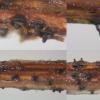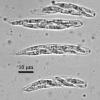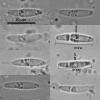
09-03-2013 17:27
Nina FilippovaGnomonia chamaemori (Gnomoniopsis chamaemori) Thi

08-03-2013 12:29
Nina FilippovaGood day.Mycosphaerella bacillifera ?I have come t

08-03-2013 12:59
 Björn Wergen
Björn Wergen
Hi there,I am looking for this article:Dulymamode,

07-03-2013 17:39
Nina FilippovaHello. Perithecioid fungi is tabula rasa for me,

06-03-2013 10:56
 Yannick Mourgues
Yannick Mourgues
Je cherche la description de Melanomma britzelmayr

07-03-2013 19:49
Nina FilippovaCompared with the description in Hawksworth, Sivan

07-03-2013 19:48
 Edit Szilvásy
Edit Szilvásy
Dear Forum, Last week I have collected these fun

04-03-2013 17:41
Hi to all Last week-end we have collected these s
This species is usual inhabitant of cloudberry leaves, especially it likes petioles and leaf veins. It fruits in june, and my august collections were almost lacking of contents, since there is no detailed microstructures description (i had only pictures of them done in june earlier).
Perithecia immersed in leaf tissues, about 200 mk in diameter, with prominent neck to 100 mk long, 50 mk thick. Asci fusiform, about 30 x 9; spores fusoid, 2-celled, hyaline, near 15 x 3, some with small appendages.
Nice finding !
It's the type species, you know.
You have perhaps read in Sogonov (2008) that apenndages are lacking in G. chamaemori. We can see them on yours. Is it an important feature ther ? I don't know.
Have you found it on Rubus chamaemorus or on another Rubus like idaeus ?
Alain
it is from Rubus chamaemorus. Yes, i learned from Sogonov that the apendages are absent. My specimens now are lacking any hymenial structures, and i can't check this clearly now, but will look at them in june. I noticed that Monod (1983) drowing of spores with some appendages. In my pictures they were similar, but to know clear more collection is needed.




